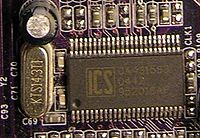
Clock generator
Encyclopedia

Clock signal
In electronics and especially synchronous digital circuits, a clock signal is a particular type of signal that oscillates between a high and a low state and is utilized like a metronome to coordinate actions of circuits...
and behaves as such) for use in synchronizing a circuit's operation. The signal can range from a simple symmetrical square wave
Square wave
A square wave is a kind of non-sinusoidal waveform, most typically encountered in electronics and signal processing. An ideal square wave alternates regularly and instantaneously between two levels...
to more complex arrangements. The basic parts that all clock generators share are a resonant circuit and an amplifier.
The resonant circuit is usually a quartz
Quartz
Quartz is the second-most-abundant mineral in the Earth's continental crust, after feldspar. It is made up of a continuous framework of SiO4 silicon–oxygen tetrahedra, with each oxygen being shared between two tetrahedra, giving an overall formula SiO2. There are many different varieties of quartz,...
piezo-electric
Piezoelectricity
Piezoelectricity is the charge which accumulates in certain solid materials in response to applied mechanical stress. The word piezoelectricity means electricity resulting from pressure...
oscillator
Electronic oscillator
An electronic oscillator is an electronic circuit that produces a repetitive electronic signal, often a sine wave or a square wave. They are widely used in innumerable electronic devices...
, although simpler tank circuits and even RC circuit
RC circuit
A resistor–capacitor circuit ', or RC filter or RC network, is an electric circuit composed of resistors and capacitors driven by a voltage or current source...
s may be used.
The amplifier
Amplifier
Generally, an amplifier or simply amp, is a device for increasing the power of a signal.In popular use, the term usually describes an electronic amplifier, in which the input "signal" is usually a voltage or a current. In audio applications, amplifiers drive the loudspeakers used in PA systems to...
circuit usually inverts the signal from the oscillator and feeds a portion back into the oscillator to maintain oscillation.
The generator may have additional sections to modify the basic signal. The 8088
Intel 8088
The Intel 8088 microprocessor was a variant of the Intel 8086 and was introduced on July 1, 1979. It had an 8-bit external data bus instead of the 16-bit bus of the 8086. The 16-bit registers and the one megabyte address range were unchanged, however...
for example, used a 2/3 duty cycle clock, which required the clock generator to incorporate logic to convert the 50/50 duty cycle which is typical of raw oscillators.
Other such optional sections include frequency divider or clock multiplier sections.
Programmable clock generators allow the number used in the divider or multiplier to be changed, allowing any of a wide variety of output frequencies to be selected without modifying the hardware.
The clock generator in a motherboard is often changed by computer enthusiasts to control the speed of their CPU, FSB, GPU and RAM
Ram
-Animals:*Ram, an uncastrated male sheep*Ram cichlid, a species of freshwater fish endemic to Colombia and Venezuela-Military:*Battering ram*Ramming, a military tactic in which one vehicle runs into another...
.
Typically the programmable clock generator is set by the BIOS at boot time to the value selected by the enthusiast; although some systems have dynamic frequency scaling
Dynamic frequency scaling
Dynamic frequency scaling is a technique in computer architecture whereby the frequency of a microprocessor can be automatically adjusted "on the fly," either to conserve power or to reduce the amount of heat generated by the chip...
that frequently re-program the clock generator.
Timing Signal Generators (TSGs)
TSGs are clockClock
A clock is an instrument used to indicate, keep, and co-ordinate time. The word clock is derived ultimately from the Celtic words clagan and clocca meaning "bell". A silent instrument missing such a mechanism has traditionally been known as a timepiece...
s that are used throughout service provider networks, frequently as the Building Integrated Timing Supply (BITS) for a central office.
Digital switching systems and some transmission systems (e.g., SONET) depend on reliable, high-quality synchronization (or timing) to prevent impairments. To provide this, most service providers utilize interoffice synchronization distribution networks based on the stratum hierarchy, and implement the BITS concept to meet intraoffice synchronization needs.
A TSG is clock equipment that accepts input timing reference signals and generates output timing reference signals. The input reference signals can be either DS1 or Composite Clock (CC) signals, and the output signals can also be DS1 or CC signals (or both). A TSG is made up of the six components listed below:
- An input timing interface that accepts DS1 or CC input signals
- A timing generation component that creates the timing signals used by the output timing distribution component
- An output timing distribution component that utilizes the timing signals from the timing generation component to create multiple DS1 and CC output signals
- A Performance Monitoring (PM) component that monitors the timing characteristics of the input signals
- An alarm interface that connects to the Central Office (CO) alarm monitoring system
- An operations interface for local craftsperson use and communications with remote operations systems.

